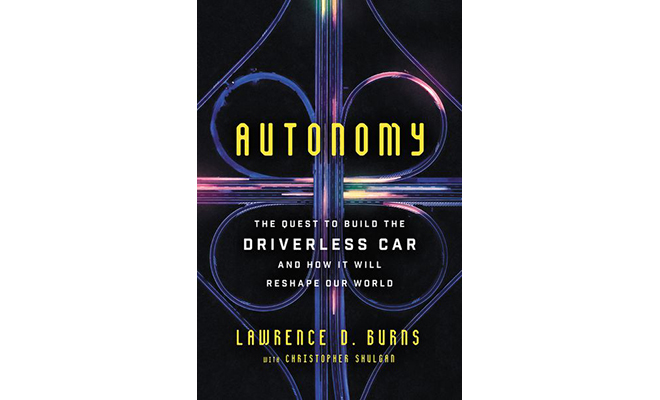When it comes to vehicle autonomy, you could hardly find someone more experienced than Larry Burns, who was deeply involved with GM’s autonomy and electrification efforts as Corporate VP of R&D and Planning from 1998 to 2009, and later an important consultant to Google’s Waymo. In “Autonomy: The Quest to Build the Driverless Car – And How It Will Reshape Our World,” Lawrence D. Burns and Christopher Shulgan tell the story of how autonomy evolved from a science fair project to a nascent industry that’s attracting billions of bucks worth of investment.
This is a good read, full of compelling stories and colorful personalities. In the first part, Burns tells us about the DARPA Challenge, in which several teams of iconoclasts and misfits straight from central casting competed to build a “robot car” that could complete an urban-style obstacle course. Here we learn some fascinating details about the mechanics of teaching cars to negotiate streets on their own.
Inexplicably, GM, which had actually funded the winning team, showed no real interest in developing autonomous technology, nor did any of the other major automakers (a tale familiar to anyone who’s followed the halting progress of electrification). It fell to Google to take up the torch. The next section of Burns’s book takes us to Silicon Valley, the land of big budgets and bigger egos. Anyone who thought of engineers as altruistic non-mercenary types may be shocked to read the highly entertaining story of the power struggles among prima donnas that brought Waymo to where it is today.
Inevitably, given his background, Burns is an unapologetic booster for vehicle autonomy, which he is convinced will reduce traffic and emissions, and almost completely eliminate crashes. Some, including your correspondent, are more skeptical. While most observers believe that AVs will improve road safety, this has yet to be proven. And the idea that they will reduce traffic seems doubtful, to say the least. If, as Burns and others predict, Transportation as a Service (TaaS) makes mobility a lot cheaper and more convenient, common sense dictates that people will use a lot more of it, starving out public transport and exacerbating sprawl.
As numerous other writers do, Burns assumes that the AVs of the future will be efficient, appropriately sized EVs, but I’ve yet to hear a convincing technical reason why this must be so. Waymo is currently using Chrysler PHEV minivans (although it has announced plans to buy Jaguar I-Paces) and Uber is using fossil fuel-powered Volvo SUVs.
Mr. Burns dismisses fears of widespread job losses, pointing out that workers displaced by previous tech revolutions eventually adapted (they did, but in more than a few cases, they also sparked revolutions and world wars). I’d be the last one to argue for attempting to protect jobs by hobbling new technologies, but I do believe that governments need to protect the workers who get screwed, and there is zero reason to expect this to be the case outside of socialist-leaning enclaves such as Scandinavia. In the US, job losses in the short and medium terms could be massive, and the political repercussions could be ugly.
Be that as it may, autonomy is coming, and Burns’s vision of the future is a positive one. I hope he’s right and I’m wrong. Either way – autonomy good or autonomy bad – this book is well worth reading.
Autonomy: The Quest to Build the Driverless Car – And How It Will Reshape Our World
by Lawrence D. Burns and Christopher Shulgan
Publisher: Ecco (August 28, 2018)
368 pages


















































































